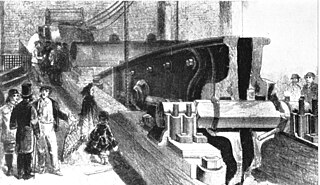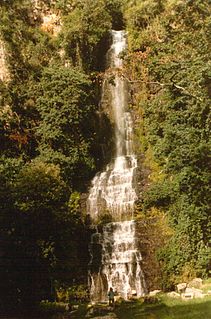
A gunnies, gunnis, or gunniss is the space left in a mine after the extraction by stoping of a vertical or near vertical ore-bearing lode. The term is also used when this space breaks the surface of the ground, but it can then be known as a coffin or goffen. It can also be used to describe the deep trenches that were dug by early miners in following the ore-bearing lode downwards from the surface – in this case they are often called open-works; their existence can provide the earliest evidence of mining in an area. William Pryce, writing in 1778, also used the term as a measure of width, a single gunnies being equal to three feet.

Arnold is the largest city in Jefferson County, Missouri, United States. The population was 20,808 at the 2010 census.

A cloudburst is an extreme amount of precipitation in a short period of time, sometimes accompanied by hail and thunder, which is capable of creating flood conditions. A cloudburst can suddenly dump large amounts of water e.g. 25 mm of precipitation corresponds to 25,000 metric tons/km2. However, cloudbursts are infrequent as they occur only via orographic lift or occasionally when a warm air parcel mixes with cooler air, resulting in sudden condensation. At times, a large amount of runoff from higher elevations is mistakenly conflated with a cloudburst. The term "cloudburst" arose from the notion that clouds were akin to water balloons and could burst, resulting in rapid precipitation. Though this idea has since been disproven, the term remains in use.
A mining accident is an accident that occurs during the process of mining minerals. Thousands of miners die from mining accidents each year, especially from underground coal mining, although hard rock mining is not immune from accidents. Coal mining is considered much more hazardous than hard rock mining due to flat-lying rock strata, generally incompetent rock, the presence of methane gas, and coal dust. Most of the deaths these days occur in developing countries, and rural parts of developed countries.
Nkana is a section of the city of Kitwe, Copperbelt Province, Zambia which started off in the early part of the 20th century as a railway station to support the growing complex of copper mining operations. It was named after Chief Nkana, the local traditional ruler. The copper mines of Nkana were originally owned by the Anglo-American Corporation of South Africa. A large smelter was built at the site of the Nkana Mine. The mines in Nkana were among the largest copper mines in the world employing in excess of 20,000 people. The city of Kitwe grew up as a service town for the Nkana mines but soon swallowed them up and the city is known as Kitwe, although the name Kitwe-Nkana is still sometimes used.

The Hartley Colliery disaster was a coal mining accident in Northumberland, England that occurred on Thursday 16 January 1862 and resulted in the deaths of 204 men. The beam of the pit's pumping engine broke and fell down the shaft, trapping the men below. The disaster prompted a change in UK law that henceforth required all collieries to have at least two independent means of escape.

Sekhukhune is one of the 5 districts of Limpopo province of South Africa. The seat of Sekhukhune is Groblersdal. The majority of its 1,076,840 inhabitants speak Sepedi. The district code is DC47.

Akizuki (秋月) was the lead ship of her class of destroyer in the Imperial Japanese Navy. Her name means “Autumn Moon.”

The 2009 Harmony Gold mine deaths occurred in late May and early June 2009 in Free State province, South Africa. At least 82 miners, many from Lesotho, Mozambique and Zimbabwe, died from inhalation of poisonous gasses created by a May 18 fire in the mineshaft.

The 2009 Handlová mine blast occurred on 10 August 2009 roughly 330 metres (1,080 ft) underground in Trencin Region, Slovakia at Hornonitrianske Bane Prievidza, a.s.s (HNB) coal mine located in the town of Handlová. 20 people were killed, nine others suffered minor injuries and were taken to hospital for treatment. Some historians have called the disaster the largest mining tragedy in Slovakia’s history. The deadly explosion, probably caused by flammable gases, occurred after mine rescuers had earlier been deployed to extinguish a fire in the Eastern shaft of the mine.

The Pike River Mine disaster was a coal mining accident that began on 19 November 2010 in the Pike River Mine, 46 kilometres (29 mi) northeast of Greymouth, in the West Coast region of New Zealand's South Island. A methane explosion occurred in the mine at approximately 3:44 pm. At the time of the explosion 31 miners and contractors were present in the mine. Two miners managed to walk from the mine; they were treated for moderate injuries and released from Greymouth Hospital the next day. The remaining 16 miners and 13 contractors were believed to be at least 1.5 kilometres (1,600 yd) from the mine's entrance.

The Chapin Mine Steam Pump Engine, also known as The Cornish Pump, is a steam-driven pump located at the corner of Kent Street and Kimberly Avenue in Iron Mountain, Michigan. It is still the largest reciprocating steam-driven engine ever built in the United States. It was listed on the National Register of Historic Places in 1981 and designated a Michigan State Historic Site in 1958.

At the start of the Battle of Messines (7–14 June 1917) during the First World War, a series of underground explosive charges were detonated by the British Army beneath German lines near the village of Mesen, in Belgian West Flanders. The mines, secretly planted by British tunnelling units, created 19 large craters and are estimated to have killed approximately 10,000 German soldiers. Their joint explosion ranks among the largest non-nuclear explosions of all time.

The Great Laxey Mine was a silver, lead ore and zinc mine located in Laxey, in the parish of Lonan, Isle of Man. The mine reached a depth in excess of 2,200 ft (670.6 m) and consisted primarily of three shafts; the Welsh Shaft, the Dumbell's Shaft and the Engine Shaft each of these shafts being connected by a series of levels.
The 2020 Women's Cricket World Cup Qualifier is an upcoming international women's cricket tournament that is scheduled to be held in Sri Lanka 2020. It will be the qualification process for the 2021 Women's Cricket World Cup. The tournament will be the fifth edition of the World Cup Qualifier. The tournament will be played as 50 overs matches. All the regional qualification tournaments used the Women's Twenty20 International format. The top three teams from the qualifier tournament will progress to the 2021 Women's Cricket World Cup in New Zealand.

Bridal Veil Falls, also known as Bridalveil Falls, is a waterfall in Chimanimani, Zimbabwe. Located within the boundaries of Chimanimani National Park, the waterfall is famed for its natural beauty.

















